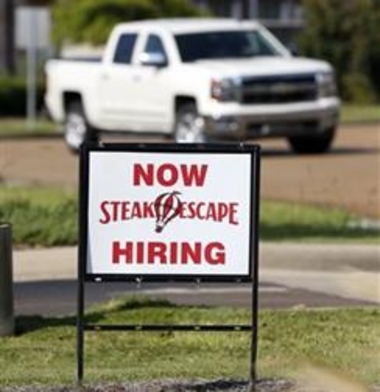US jobless rate falls to 6-year low of 5.9 pct.

Washington (AP) — U.S. employers added 248,000 jobs in September, a burst of hiring that helped drive down the unemployment rate to 5.9 percent, the lowest since July 2008.
The Labor Department report Friday also showed that employers added a combined 69,000 more jobs in July and August than the government had previously estimated.
The unemployment rate fell from 6.1 percent in August and is now close to 5.5 percent, which many economists consider a healthy level. The lower rate, combined with the surge in hiring, could ratchet up pressure on the Federal Reserve to raise its benchmark interest rate earlier than expected. Most economists have predicted that the Fed would start raising rates in mid-2015.
The job gains were broad-based and included many higher-paying industries. Professional and business services, which includes engineers, accountants and architects, added 81,000 jobs, the most in seven months. Construction companies added 16,000 jobs, manufacturing 4,000.
Economists noted, though, that average hourly wages didn't budge last month, a surprising trend in light of the healthy job growth. Joseph Brusuelas, chief economist for the consulting firm McGladrey LLP, suggested that more jobs in better-paying industries haven't yet translated into higher pay because employers still have so many applicants to choose from.
"Policymakers will certainly be worried by the lack of wage growth," said Chris Williamson, chief economist at Markit. "Without substantially higher wage growth, the fear is that households will pull back on consumption if interest rates and borrowing costs start rising, snuffling out the wider economic recovery."
Stock futures rose after the news was released, a sign that investors are optimistic about the U.S. economy.
The improved job growth comes after President Barack Obama touted his administration's economic achievements in a speech Thursday. The economy is the top issue in voters' minds as the November elections near.
The number of unemployed fell in September by 329,000 to 9.3 million. Most of them found jobs. But nearly 100,000 stopped looking for work. Their exodus lowered the percentage of Americans working or looking for work to 62.7 percent, the lowest proportion since February 1978.
Friday's report will likely intensify debate among Fed policymakers over how close the job market is to full health. Fed Chair Janet Yellen has said she is tracking many other gauges besides the unemployment rate, most of which still show scars from the Great Recession.
For example, there were 7.1 million people working part-time jobs last month even though they would prefer full-time work. That figure is up from just 4.6 million before the recession.
And there are 3 million people who have been out of work for more than six months. That figure has declined steadily in the past three years but is still more than double its precession total.
A broader measure of unemployment that includes part-time workers who would prefer full-time jobs, as well as those who have stopped searching, fell to 11.8 percent last month from 12 percent in August.
September's job gain means that more Americans are earning paychecks and can spend more. The annual pace of economic growth is expected to remain above 3 percent for the rest of the year. Business investment is picking up, and consumer spending is growing at a steady if modest pace.
Joseph LaVorgna, an economist at Deutsche Bank, notes that productivity — the amount of output per hour of work — is rising 1 percent annually. LaVorgna thinks the economy is expanding at a 3 percent annual pace and that hiring should grow roughly 2 percent a year. That would translate into 230,000 jobs each month, he calculates.
Just 287,000 people sought unemployment benefits last week, not far from a seven-year low reached in July. The number of people receiving benefits has reached an eight-year low, a sign that companies are confident enough in their customer demand to retain their staff levels.
Business investment in equipment and buildings rose 9.7 percent in the second quarter, the second-highest figure in the past three years. And orders for capital goods, a sign of future business spending, rose in August.
Americans have generally spent cautiously this year, held back by sluggish wage growth. Average hourly pay has barely kept up with inflation in the past three years.
___
by Christopher S. Rugaber, AP Economics Writer. AP Economics Writer Paul Wiseman contributed to this report.
Copyright 2014 The Associated Press. All rights reserved. This material may not be published, broadcast, rewritten or redistributed.
The Gayly – October 3, 2014 @ 9:10am





